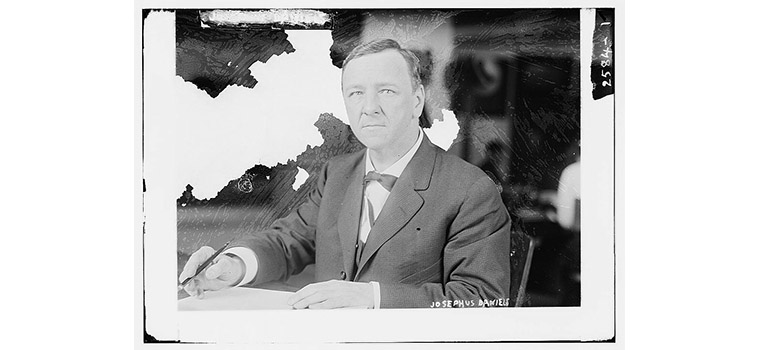Why is coffee sometimes referred to as "a cup of joe"? Well, there's a nautical story that many people think is the origin of the expression.

Josephus Daniels was appointed by United States President Woodrow Wilson to serve as Secretary of the Navy during World War I. Library of Congress
BY CAPTAIN RAY
Published: August, 2017
Why is coffee sometimes referred to as “a cup of joe”? Well, there’s a nautical story that many people think is the origin of the expression. Bear with me for a bit of history first...
There is a custom in Hawai’i known as the pau hana drink. Pau hana means “done working,” and when the work is finished for the day and before going home, you and your workmates share a drink (usually beer). I’m not much of a beer drinker, so during the years I was a charter skipper in Hawai’i, the custom evolved into a Cuba Libre (rum and coke with a squirt of lime). Rum being a sailor’s drink, of course. Once the charter guests were discharged, we would relax with a Cuba Libre before setting about the business of squaring away the boat, then (perhaps) another when all was shipshape again.
But, how is it that rum became so associated with sailors?
Alcoholic beverages of some sort have always been a part of the ship’s provisions. For the Royal Navy of the 1600s, it was beer in the cooler climate around the British Isles, red wine (usually Spanish) or brandy in the Mediterranean. However, these beverages were not stable and would often spoil during the long deployments of the fleet. To at least partially offset this troubling occurrence, the great British explorer and seaman Captain James Cook was known to brew fresh beer on his long voyages to the Pacific Ocean.
In May 1655, the British Admiral William Penn and General Robert Venables invaded Jamaica with a force of 7,000 and took it from the Spanish. It wasn’t very hard; there were only about 2,000 settlers and almost no regular army. During the ensuing war, the primary occupation of this new British outpost was piracy, but with peace came agriculture. That meant sugarcane and, with the growing of sugarcane, the production of rum.
Rum began to replace beer and other libations aboard British ships because it was cheap, readily available, and it took less space to store because of its higher alcohol content. It also improved with age! Originally, a pint a day—remember, this stuff was often over 100 proof—was the normal allotment. In 1731, the Royal Navy lowered the seaman’s daily allowance to a half pint, to be issued half in the morning and half in the evening. Despite this significant reduction, drunkenness remained a significant problem, especially in the West Indies.
In August 1741, Vice Admiral Edward Vernon, commander in chief of the West Indies Station, ordered that from now on the rum ration would be mixed with water before being issued. He also decreed that sugar and limes (for the prevention of scurvy) be made available to the crew. Because of his habit of wearing clothes made of grogram—a rather coarse fabric made of a mixture of silk and wool—he had acquired the nickname “Old Grog,” and this watered rum mixture became known as grog.
Over the following centuries, the ration was reduced or restricted several times. In 1850, it was halved again to a quarter pint, and in 1881 the ration was no longer issued to officers, was reduced to an eighth of a pint, and was restricted to crew members at least 20 years old.
In July 1970, the British Royal Navy discontinued the rum ration entirely, feeling that it was not in keeping with having to operate the complex machinery of a modern warship. The tradition remained in the Royal New Zealand Navy however, until February 1990.
But this started out as a story about coffee. The tradition of the rum ration was a part of the United States Navy also. It was not until July 1, 1914 that Secretary of the Navy Josephus Daniels issued General Order 99, which prohibited “the use or introduction for drinking purposes of alcoholic liquors on board any naval vessel, or within any navy yard or station.” Instead, he proposed coffee. The crew then began to refer to coffee (somewhat sarcastically) as “a cup of joe.”
Ray Wichmann is a US SAILING-certified Ocean Passagemaking Instructor, a US SAILING Master Instructor Trainer, and a member of US SAILING’s National Faculty. He holds a 100-Ton Master’s License, was a charter skipper in Hawai’i for 15 years, and has sailed on both coasts of the United States, in Mexico, the Caribbean and Greece. He is presently employed as the Master Instructor at OCSC Sailing in the Berkeley Marina.

